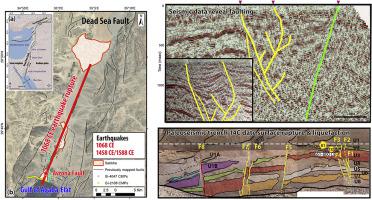当前位置:
X-MOL 学术
›
Tectonophysics
›
论文详情
Our official English website, www.x-mol.net, welcomes your
feedback! (Note: you will need to create a separate account there.)
Seismic potential of the Dead Sea Fault in the northern Gulf of Aqaba-Elat: New evidence from liquefaction, seismic reflection, and paleoseismic data
Tectonophysics ( IF 2.7 ) Pub Date : 2020-10-01 , DOI: 10.1016/j.tecto.2020.228596 Mor Kanari , Tina M. Niemi , Zvi Ben-Avraham , Uri Frieslander , Gideon Tibor , Beverly N. Goodman-Tchernov , Neta Wechsler , Abdelrahmen Abueladas , Abdallah Al-Zoubi , Uri Basson , Shmuel Marco
Tectonophysics ( IF 2.7 ) Pub Date : 2020-10-01 , DOI: 10.1016/j.tecto.2020.228596 Mor Kanari , Tina M. Niemi , Zvi Ben-Avraham , Uri Frieslander , Gideon Tibor , Beverly N. Goodman-Tchernov , Neta Wechsler , Abdelrahmen Abueladas , Abdallah Al-Zoubi , Uri Basson , Shmuel Marco

|
Abstract The cities of Elat, Israel and neighboring Aqaba, Jordan are major economic, cultural, and seaport centers. They are located on the northern shore of the Gulf of Aqaba/Elat (GAE) directly on the Dead Sea Transform. Yet the precise location of the fault trace and its tectonic activity are lacking. The interpretation of seismic reflection profiles across the GAE beach and paleoseismic trench data located 2.2 km north of the shoreline provide evidence that the active offshore mapped Avrona Fault extends onland along the eastern side of the Elat Sabkha (mudflat), where three prominent fault strands crosscut the sedimentary fill. Mismatch of reflector geometry across the faults and flower structures indicate strike-slip faulting with a normal-slip component. Subsurface data from two trenching sites provide evidence for a minimum of two surface ruptures and two paleoliquefaction events. Faulting is constrained by radiocarbon dating for an Event 1 between 897 and 992 CE and Event 2 after 1294 CE. We suggest that the historically documented 1068 CE, and at least one later earthquake in 1458 or 1588 CE, ruptured the Elat Sabkha site. Based on fault mapping, we suggest a minimum value of M 6.6 for the 1068 CE earthquake. Whereas no surface rupture was observed for the 1212 CE historical earthquake, fluidized strata radiocarbon dated to before 1269–1389 CE identified as paleoliquefaction may be attributed to it. Two liquefaction sand-blows mapped in the trench likely formed after 1337 CE and before 1550 CE, which possibly occurred at the same time as in the second faulting event. Our data suggest that no large event occurred along the Avrona segment in the past ~430–550 years. Given a ~ 5 mm/yr slip rate, we conclude that a significant period of time passed since the last surface rupturing on the Avrona Fault, increasing its seismic potential.
中文翻译:

亚喀巴-埃拉特湾北部死海断层的地震潜力:来自液化、地震反射和古地震数据的新证据
摘要 以色列埃拉特市和邻近的约旦亚喀巴市是主要的经济、文化和海港中心。它们位于亚喀巴湾/埃拉特 (GAE) 北岸,直接位于死海转换处。然而,缺乏断层痕迹的精确位置及其构造活动。跨 GAE 海滩的地震反射剖面和位于海岸线以北 2.2 公里处的古地震海沟数据的解释提供证据表明,活动的海上测绘的 Avrona 断层沿 Elat Sabkha(泥滩)东侧向陆上延伸,其中三个突出的断层链横切沉积充填。跨断层和花状结构的反射器几何形状不匹配表明走滑断层具有正常滑动分量。来自两个挖沟地点的地下数据提供了至少两次地表破裂和两次古液化事件的证据。对于公元 897 年和 992 年之间的事件 1 和公元 1294 年之后的事件 2,断层受到放射性碳测年的限制。我们认为,历史上记录的公元 1068 年,以及至少后来发生的 1458 年或 1588 年的一次地震,使 Elat Sabkha 遗址破裂。根据断层图,我们建议 1068 CE 地震的最小值为 M 6.6。尽管在公元 1212 年的历史地震中没有观察到地表破裂,但确定为古液化作用的公元 1269-1389 年之前的流化地层放射性碳可能归因于它。绘制在海沟中的两次液化沙流可能形成于公元 1337 年之后和公元 1550 年之前,这可能与第二次断层事件同时发生。我们的数据表明,在过去的约 430-550 年中,Avrona 段没有发生大事件。假设滑动率约为 5 毫米/年,我们得出结论,自 Avrona 断层上次表面破裂以来已经过去了很长一段时间,增加了其地震潜力。
更新日期:2020-10-01
中文翻译:

亚喀巴-埃拉特湾北部死海断层的地震潜力:来自液化、地震反射和古地震数据的新证据
摘要 以色列埃拉特市和邻近的约旦亚喀巴市是主要的经济、文化和海港中心。它们位于亚喀巴湾/埃拉特 (GAE) 北岸,直接位于死海转换处。然而,缺乏断层痕迹的精确位置及其构造活动。跨 GAE 海滩的地震反射剖面和位于海岸线以北 2.2 公里处的古地震海沟数据的解释提供证据表明,活动的海上测绘的 Avrona 断层沿 Elat Sabkha(泥滩)东侧向陆上延伸,其中三个突出的断层链横切沉积充填。跨断层和花状结构的反射器几何形状不匹配表明走滑断层具有正常滑动分量。来自两个挖沟地点的地下数据提供了至少两次地表破裂和两次古液化事件的证据。对于公元 897 年和 992 年之间的事件 1 和公元 1294 年之后的事件 2,断层受到放射性碳测年的限制。我们认为,历史上记录的公元 1068 年,以及至少后来发生的 1458 年或 1588 年的一次地震,使 Elat Sabkha 遗址破裂。根据断层图,我们建议 1068 CE 地震的最小值为 M 6.6。尽管在公元 1212 年的历史地震中没有观察到地表破裂,但确定为古液化作用的公元 1269-1389 年之前的流化地层放射性碳可能归因于它。绘制在海沟中的两次液化沙流可能形成于公元 1337 年之后和公元 1550 年之前,这可能与第二次断层事件同时发生。我们的数据表明,在过去的约 430-550 年中,Avrona 段没有发生大事件。假设滑动率约为 5 毫米/年,我们得出结论,自 Avrona 断层上次表面破裂以来已经过去了很长一段时间,增加了其地震潜力。











































 京公网安备 11010802027423号
京公网安备 11010802027423号